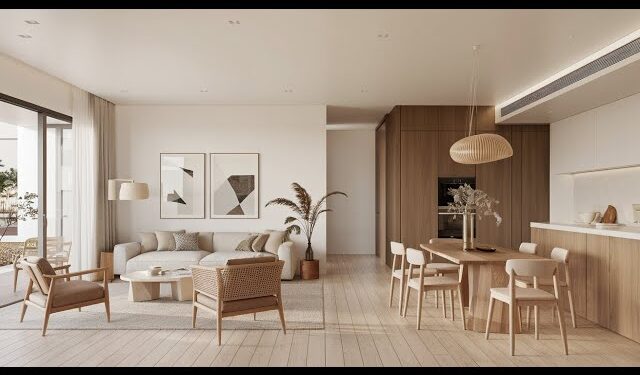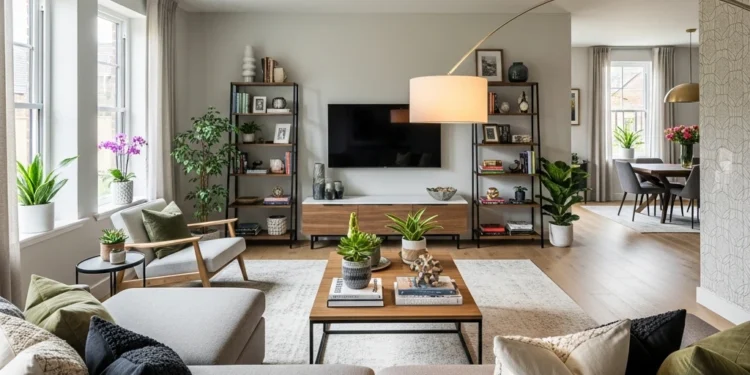Japandi continues to be an enduring trend as this minimalist interior design scheme is still a favorite among homeowners and interior designers. Combining the best of Japanese and Scandinavian design influences, it’s the perfect choice for those who want to create calming spaces in their home. In a Vogue interview, interior stylist Colin King said that Japandi is the perfect hybrid between two cultures that put a premium on tranquility and minimalism. “It celebrates everyday beauty and a connection with nature and shares a simplified aesthetic,” he adds.
It’s likely that living in a time of uncertainty, as well as the hectic nature of modern living has created the need for soothing and peaceful spaces. If you’re looking to add some serenity to your life, here are some easy ways to transform your home with the Japandi design trend.
Choose a Nature-Inspired Color Palette
Choosing a nature-inspired color palette is the first step to achieve a Japandi-style home. This palette features soft, earthy colors to create a sense of peace and understated elegance, adding an organic feel to living spaces. To create a Japandi color palette, use creamy whites, mid-tone browns, medium and smokey grays, muted greens, and a touch of black here and there.
Select large pieces of furniture in light wood tones, then use white paint on the walls. To add some interest to your decor, choose accent pieces and decorative items in dark colors. So, for instance, if you’re planning to add beech or oak floating shelves in your living room, decorate them with charcoal-hued pottery and sculptures, as well as dark colored picture frames to display prints and personal photos. If you feel like your space needs a bit more color, add soft furnishings or accessories in neutral tones with a hint of warm pastel hues. Think of throw pillows in a soft pink beige or light salmon, or go for a beige with a light yellow undertone.

Organic Materials and Touchable Textiles
Warmth, comfort, and simplicity are some of the principal style cores of Japandi, so materials like chrome, plastic, acrylic, or aluminum are definite no-nos. Instead, choose natural materials like wood, reclaimed wood, or bamboo when picking out furniture, especially for the living room. Pick substantial pieces instead of flimsy ones to anchor the room and give it character. For coziness and comfort, top a wooden sofa and seats with plush cushions and pillows, then add a Scandinavian touch with a white or beige fur, sheepskin, or shearling throw. Finish with a live edge, Japanese-style coffee table and organic shaped side tables.
Hang off-white or cream linen curtains to dress up your windows, then add a beige or oat handwoven rug with a low knotted pile height. You can also have a few jute area rugs to define spaces, but to stay true to the Japandi design scheme, choose plain ones over patterned rugs, or jute rugs with geometrical designs near the edges. If you need a statement piece, add a wood slat room divider to break up a huge space. You can choose a divider with vertical slats, or one with built-in mini shelves so you can fill them with decorative items and accessories.
Understated Accessories and Decorative Items
One of the best things about the Japandi interior design trend is that you don’t need flashy home accessories to make a style statement. When decorating, go for simple or understated pieces that have lots of impact. Think of hanging oversized paper lanterns made from handmade washi paper in the dining area or above your kitchen counter. You can also display a set of black or moss green terra cotta espresso cups and saucers, or a Japanese style black pottery tea set on a kitchen shelf or a side table.
For a bit of rustic charm, display a piece of driftwood in the living room or dining room, then add statement lighting for visual impact. Place sculptures and pottery with rounded shapes in strategic places in your house, then pair with accessories such as incense holders or palo santo and green tea scented candles. Finally, incorporate more nature into your home with a few Japandi-style plants. Some indoor plants that will go well with your chosen design theme include potted olive trees, fiddle leaf fig, Ficus benjamina, and ZZ plants. Place your plants in white oversized planters with a rounded shape, or in tall, matte black ceramic planters.
The Japandi interior design trend is here to stay. Consider these tips to dress up your home with Japanese and Scandinavian design elements, and create serene, elegant and comfortable spaces in your abode.












